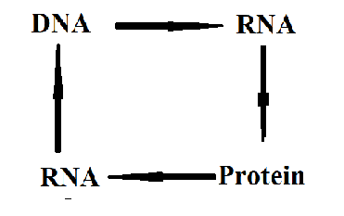- The central dogma is the flow of information (DNA—RNA–Protein). The process of central dogma explains how the DNA is converted into a functional product. It was first proposed by Francis Crick (1957) and published (1958).
- Central Dogma also confirms that our DNA contains all the information that is required to make proteins.

- A gene is expressed when:
- DNA is transcribed to RNA, then RNA is transcribed to protein.
What is Gene Expression?
Gene expression is the process by which DNA instructions get converted into a functional product.
The Pattern of central dogma:
Transcription is the first process in central dogma it does not involve a change of code since DNA and mRNA are complementary.
The second step involves a change of code from nucleotide sequences this process is known as translation.
According to the central dogma flow of information (DNA-RNA-protein) is a one-way process. Barry Commoner (1968) suggested a circular flow of information:
DNA-RNA-Protein-RNA-DNA
RNA depended DNA polymerase is an existing enzyme that could synthesize DNA from an ssRNA template proposed by Temin in 1970. In 1970 D. Baltimore has also reported the activity of RNA depended DNA polymerase in certain tumor RNA viruses. The discovery of this enzyme gave rise to Central dogma Reverse or terminism, it suggests the sequence of information is not necessarily from DNA-RNA-Protein, but it can also take place From DNA to RNA.
Transcription:
The synthesis of RNA from pre-existing DNA is called Transcription. It has three phases
- Initiation
- Elongation
- Termination
- Initiation: RNA polymerase recognizes and binds to a promoter region/ sequence on DNA.
- Elongation: RNA polymerase elongates the RNA in 5`-3` direction, nucleotides are added by complementary base pairing with template strand.
- Termination: Special DNA sequences and proteins helps to terminate the process. Pre mRNA is released and processed to generate mature mRNA.
Translation:
Synthesis of protein from RNA.
STEPS:
- Pre-initiation: Charging of tRNA or aminoacylation of tRNA and formation of the initiation complex.
- Initiation: A, P, E sites
A site: the only thing that can enter is an Aminoacyl tRNA.
P site: the only thing that can enter is a peptide.
E site: exit site.
Ribosome: composed of Two subunits during Translation these two units come together near 5` side around an mRNA molecule.
The small subunit matches the tRNA to the codon of mRNA.
The large subunit catalyzes the formation of the peptide bonds between amino acid in the rising polypeptide chain.
- Elongation: amino acids are carried together to Ribosomes by the help of tRNA and linked to form a chain.
- Termination: polypeptide is released, components are reprocessed to make another polypeptide (protein).